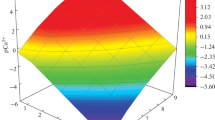Abstract
We used a battery of different methods to study the association in aqueous sodium dehydrocholate (NaDHC) solutions. This salt associates by a stepwise mechanism. Below (9.6 ± 4.2) × 10−4 mol dm−3 there is a molecular solution with some strongly insoluble dehydrocholic acid produced by hydrolysis. Between (9.6 ± 4.2) × 10−4 and (5.2 ± 2.2) × 10−3 mol dm−3, an aggregate similar to acid soap (NaDHC.HDHC) appears and its amount and the aggregate's size increase with concentration. At =(2.20 ± 0.85) × 10−2 mol dm−3 the aggregates formed have properties usually associated with true micelles, such as solubilisation of water-insoluble dyes. These aggregates increase in size with concentration and change their shape at 8 × 10−2 mol dm−3, giving nonsymmetrical aggregates. The changes in the solution physicochemical properties at these concentrations may be misinterpreted and this explains the different values of the critical micelle concentration reported in the literature for substances with similar structure, such as bile salts.
Similar content being viewed by others
Author information
Authors and Affiliations
Additional information
Received: 14 May 2001 Accepted: 10 August 2001
Rights and permissions
About this article
Cite this article
Messina, P., Morini, M., Schulz, P. et al. The aggregation of sodium dehydrocholate in water. Colloid Polym Sci 280, 328–335 (2002). https://doi.org/10.1007/s00396-001-0594-7
Issue Date:
DOI: https://doi.org/10.1007/s00396-001-0594-7




